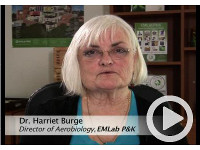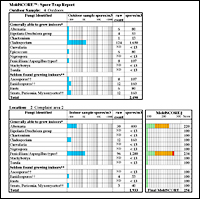The MoldSCORE™ Report – An Expert Second Opinion for Your Mold InvestigationWhat Is MoldSCORE™?MoldSCORE™ is a number estimating how an outside mold expert would interpret a set of mold data. It's purpose is not to provide the 'final answer' for your mold investigation since that requires knowledge of the onsite conditions and related information, but rather MoldSCORE™ provides a 'second opinion' that may be useful to professional mold inspectors. MoldSCORE™ was rigorously developed and tested by experienced mold professionals. MoldSCORE™ uses a large database of detailed information about fungi found on fungal air samples to provide a useful "mold score" to complement your mold investigation. How Can MoldSCORE™ Help in My Mold Investigations?When evaluating indoor levels of most pollutants, you can collect air samples, compare your sampling results to established exposure standards, and make relatively unambiguous decisions regarding the need for remediation. Results from airborne mold samples are not amenable to this general methodology, due to difficulties in developing such exposure standards for reasons discussed at length elsewhere, and are largely related to the fact that mold spores are a natural part of the environment and normally found both inside and outside of buildings. Consequently, in the case of airborne mold samples, one must rely on a different general test methodology that considers not only the overall level of mold spores, but also a comparison of these levels to background levels for each type of mold spore. Although mold investigations designed to reveal the presence or absence of such growth should always rely primarily on visual inspections by experienced mold investigators, it is often necessary to use sampling as auxiliary support. Advanced education and experience in aerobiology and indoor air quality investigations are required to qualitatively interpret fungal air data that compare indoor and outdoor spore concentrations. Many experts have found MoldSCORE™ to be a useful aid, or 'second opinion,' in evaluating mold data. Other Methods for Interpreting Indoor/Outdoor DataSeveral different quantitative guidelines for interpretation of indoor/outdoor data have been published. These include a requirement that indoor levels be lower than those outdoors, with indoor/outdoor ratios >1 indicating an indoor problem. Others have modified this ratio approach by requiring a minimum concentration of spores and a higher ratio to indicate a problem. Better, some have used indoor/outdoor ratios of specific types of spores or have subtracted outdoor concentrations of specific fungi from those indoors. Statistical approaches have also been used including applying the Spearman Rank Correlation to fungal data. How Do Other Methods Perform in Calculating A Mold Score?None of these approaches provides the quality of information a highly qualified expert could give, nor do they evaluate directly whether the data supports the hypothesis of indoor mold growth. Indoor/outdoor ratios that do not take spore types into consideration do not provide any information on differences in indoor and outdoor population structures. Comparing specific spore types, which is a part of the Spearman, agreement ratio, and cluster analysis tests, provides additional information, but does not take into account other important sources of information used by the experts, such as differences in fungal ecology. Further, these statistical techniques were designed for large data sets, which are rarely available for indoor air investigations. Scientifically Developed Mold ScoreIn response to the need for a standardized method for evaluating homes on a case-by-case basis, we used an aerobiological approach to develop MoldSCORE™, which is designed to mimic the performance of experts over a wide range of fungal air data sets and to be used for epidemiological studies and event investigations in conjunction with a visual inspection by a qualified professional. The MoldSCORE™ statistical analysis was developed by three in-house experts, with broad experience in interpreting indoor/outdoor ratios, working together with computer programmers and a Ph.D. physicist. Some factors taken into consideration include: 1) concentrations of individual spore types indoors and outdoors, 2) presence or absence of marker spores indoors, 3) expected range of outdoor concentrations for specific spore types, 4) analytical protocols used, and 5) types of substrates each spore type is capable of utilizing. The resulting algorithm is not a rule-based artificial intelligence system, but rather a specialized statistical analysis tool. How Does MoldSCORE™ Perform in Calculating A Mold Score?
We tested MoldSCORE™ using 100 reports from onsite mold investigations in which both indoor
and outdoor measurements of spore populations were sampled using spore traps. The software
then calculated the mold score for the reports. At the same time, the experts were asked to
judge on a scale of 1 to 100 the probability that the data in each report suggested indoor
fungal growth in the area tested. After approximately a month, we asked each expert to
re-evaluate the 100 field reports so that we could calculate within expert variability. This
effort was followed by an onsite discussion among the experts and by an adjustment of either
the expert score or the MoldSCORE™ methodology.
Watch the MoldSCORE™ video and learn from Dr. Harriet Burge! How do I sign up to receive MoldSCORE™ with my reports?
If you are a current client, please contact your project manager
who can generate this report for you for any specific set of data you'd like or to set up your
reporting preferences to automatically receive this report.
|
|

